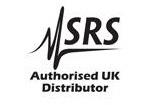SRS SIM921 AC Resistance Bridge
Accurate millikelvin thermometry:
- Microvolt/picoamp excitation
- Measurements from 1 mΩ to 100 MΩ
- Variable excitation from 2 Hz to 60 Hz
- Linearised analog output
- Resistance, temperature and phase
Lambda Exclusive Promotion:
Additional 12 months warranty for free (2 years total) via our UK Service Centre.
Measuring Resistance
The SRS SIM921 measures resistance using a four-wire circuit, eliminating the direct effect of lead resistance on the result. Thermal EMFs and amplifier offset drifts are avoided by using an AC excitation current source.
The excitation frequency can be adjusted from 2 Hz to 60 Hz, either from the front panel or over the computer interface. This flexibility allows the user to operate at a synchronous sub-harmonic of the power line frequency (such as 15 Hz/12.5 Hz) or at some incommensurate frequency, depending on requirements. Multiple SIM921s can be operated at different frequencies in the same experimental set-up without risking in-band crosstalk. Also, for very high impedance measurements, the variable frequency makes it possible to probe any capacitive effects in the resistance result. Excitations are sinusoidal, eliminating the high-frequency harmonic content associated with square wave excitations.
The actual determination of resistance is achieved ratiometrically, passing the selected excitation current through both an internal high-stability reference resistor as well as the user's device under measurement. An internal autocal is available to calibrate the two arms of the ratio readout for greater accuracy.
Excitation
Two excitation modes, constant current and constant voltage, are available with the SIM921. Most low temperature thermometry applications use negative temperature coefficient resistors. The constant voltage mode has the benefit of decreasing the power dissipated in the thermometer as the temperature drops. In this mode, the SIM921 servos the applied AC excitation to maintain the selected voltage across the user's resistor.
Constant current mode is appropriate when measuring small resistances, such as characterizing superconducting transitions. In constant current mode, the internal reference resistor is used as the input to the servo, giving a constant current equal to the selected voltage divided by half the resistance range (for instance, 100 µV on the 20 kΩ range gives 10 nA RMS excitation current).
Phase Sensitive Detection
A pair of dual-phase sinusoidal AC demodulators in the SIM921 provide excellent signal-to-noise ratio in the most difficult test conditions. Further, dual phase demodulation enables resistance and phase shift measurements. Large phase shifts can warn the user of excessive lead reactance. Selectable post-demodulation time constants from 300 ms to 300 s give you complete control over the trade-off between measurement response time and ultimate resolution.
Autorange
When autoranging is selected, the SIM921 dynamically adjusts the bridge amplifier gains for optimal performance with small signals and rescales the display based on the measured result. By disabling autoranging, the display range is held fixed and the bridge amplifiers are kept at full-scale gain. This can be particularly important when using the SIM921 in a control loop application. In both autorange and manual range mode, the excitation settings are never changed by the instrument, ensuring the user complete control over measurement conditions in an experiment.
Thermometry
The SIM921 is compatible with all resistive sensors including NTC sensors (germanium, Carbon-Glass™, carbon-composition, Cernox™, ruthenium oxide, etc.), and PTC sensors (rhodium-iron RTD, platinum RTD, etc.). Up to four user calibration curves (ohm to kelvin), with 200 points of data each, can be uploaded to the instrument via the computer interface.
Output
In addition to the display output and computer interface, an analog output provides a DC voltage proportional to either resistance or temperature. The user has full control over the scale (V/K or V/Ω ) and offset (K or Ω) of this output.
Temperature Control
The analog output signal is well suited to connect with the SIM960 Analog PID Controller. This combination of modules provides a flexible and cost-effective temperature control solution.
Front Panel Display
The primary readout is an easy-to-read 5½-digit LED display (statically driven for low noise). This display can show measured value (resistance or temperature), value minus offset, phase shift, offset, excitation frequency, analog output scale, and cal-curve. Separate bar-style displays indicate the resistance range, excitation, and output time constant as well as excitation mode (current or voltage) and autorange setting.
Interfaces
All instrument parameters can be controlled and displayed on the front panel or set and queried over the computer interface. The analog DC output is available on a front panel BNC connector.
The rear panel has a standard 9 pin D-sub connector for the sensor. Power and serial communications are via the 15-pin D-sub connector which mates with the SIM900 mainframe. Stand-alone operation of the SIM921 is possible by providing ±15 V and +5 V power directly on the 15-pin connector.
Resolution
Resolution is given in the table below. Upper values give excitation current, while lower values are typical RMS resistance noise measured at 50 % full scale on a room temperature resistor with a 3 s output time constant.
| Range | 30 mV | 10 mV | 3 mV | 1 mV | 300 µV | 100 µV | 30 µV | 10 µV | 3 µV |
| 20 mΩ | N/A | N/A | N/A | N/A | N/A | 100 mA 44 µΩ | 3 mA 130 µΩ | 1 mA 510 µΩ | 300 µA 1.5 mΩ |
| 200 mΩ | N/A | N/A | N/A | 10 mA 8.9 µΩ | 3 mA 12 µΩ |
1 mA 32 µΩ |
3 mA 120 µΩ | 100 mA 590 µΩ | 300 µA 1.5 mΩ |
| 2 Ω | N/A | 10 mA 4.3 µΩ | 3 mA 5.5 µΩ | 1 mA 7.9 µΩ |
300 µA 23 µΩ | 100 µA 70 µΩ | 30 µA 220 µΩ | 10 µA 730 µΩ | 3 µA 1.8 mΩ |
| 20 Ω | 3 mA 20 µΩ |
3 mA 21 µΩ |
300 µA 33 µΩ | 100 µA 41 µΩ | 30 µA 100 µΩ | 10 µA 390 µΩ | 3 µA 1.7 mΩ |
1 µA 4.1 mΩ |
300 nA 10 mΩ |
| 200 Ω | 300 µA 200 µΩ | 100 µA 200 µΩ | 30 µA 370 µΩ | 10 µA 430 µΩ | 3 µA 1.1 mΩ |
1 µA 2.8 mΩ |
300 nA 9.7 mΩ | 100 nA 25 mΩ | 30 nA 120 mΩ |
| 2 kΩ | 30 µA 2.0 mΩ | 10 µA 2.0 mΩ | 3 µA 2.9 mΩ |
1 µA 4.0 mΩ |
300 nA 12 mΩ | 100 nA 40 mΩ | 30 nA 120 mΩ | 10 nA 300 mΩ | 3 nA 900 mΩ |
| 20 kΩ | 3 µA 20 mΩ |
1 µA 25 mΩ |
300 nA 31 mΩ | 100 nA 56 mΩ | 30 nA 200 mΩ | 10 nA 640 mΩ | 3 nA 2.4 Ω |
1 nA 5.3 Ω |
300 pA 23 Ω |
| 200 kΩ | 300 nA 250 mΩ | 100 nA 350 mΩ | 30 nA 640 mΩ | 10 nA 1.4 Ω | 3 nA 4.5 Ω |
1 nA 16 Ω |
300 pA 47 Ω | 100 pA 150 Ω | 30 pA 710 Ω |
| 2 MΩ | 30 nA 3.4 Ω | 10 nA 5.9 Ω | 3 nA 16 Ω |
1 nA 46 Ω |
300 pA 190 Ω | 100 pA 480 Ω | 30 pA 1.7 kΩ | 10 pA 5.4 kΩ | 3 pA 15 kΩ |
| 20 MΩ | 3 nA 50 Ω |
1 nA 190 Ω |
300 pA 540 Ω | 100 pA 1.1 kΩ | 30 pA 5.4 kΩ | 10 pA 12 kΩ | 3 pA 56 kΩ |
1 pA 180 kΩ | 300 fA 750 kΩ |
The figure shows the overall architecture of the SIM921 AC Resistance Bridge. A sinusoidal excitation is applied to the half-bridge formed by the internal reference resistor RREF and the external user's resistor under measurement RM (dashed box). Two parallel low noise differential amplifiers measure the AC voltage across RREF and RM via kelvin leads. The results, ISIG and VSIG, are sent to separate dual phase demodulators to produce the vector quantities I and V. Finally, the in-phase component of current is divided into the measured voltage to determine the value of RM.
| Measurement | |
| Measurement type | 4 wire AC bridge |
| Number of inputs | 1 |
| Resistance range | 1 mΩ to 100 MΩ |
| Time constant | 0.3 s to 300 s |
| Reading rate | 2 updates/s |
| Demodulator resolution | 32-bit |
| Resolution | see table |
| Accuracy (% reading + % range): |
| Photo | Product | SKU | |
|---|---|---|---|
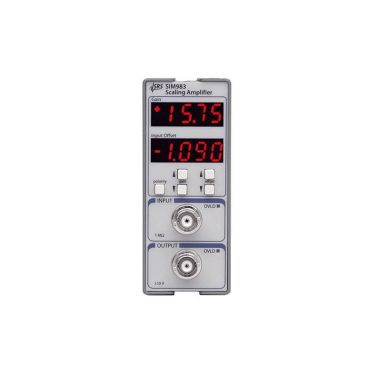 |
SRS SIM983 1 MHz Scaling Amplifier | - | > |
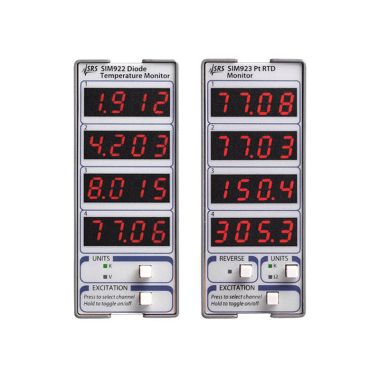 |
SRS SIM922 Diode Temperature Monitors | - | > |
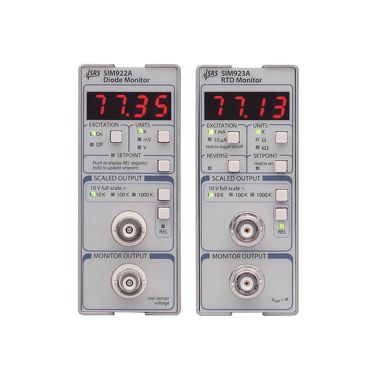 |
SRS SIM922A Diode Monitor | - | > |
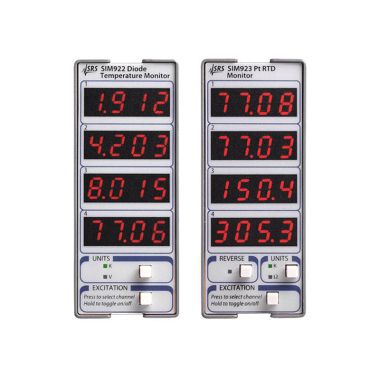 |
SRS SIM923 Platinum RTD Temperature Monitors | - | > |
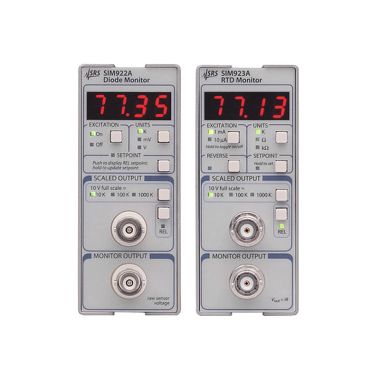 |
SRS SIM923A Platinum RTD Temperature Monitors | - | > |
 |
SRS SR630 16 Channel Thermocouple Monitor | - | > |
 |
Pico Technology Pico TC-08 Thermocouple Data Logger | - | > |
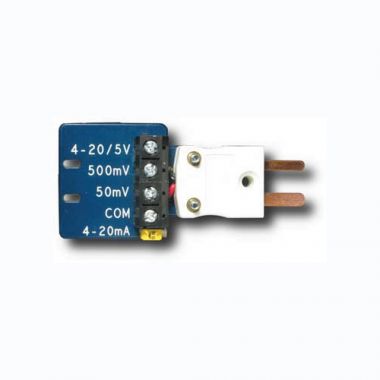 |
Pico Technology PR121 USB TC-08 Single Channel Terminal Board | - | > |





